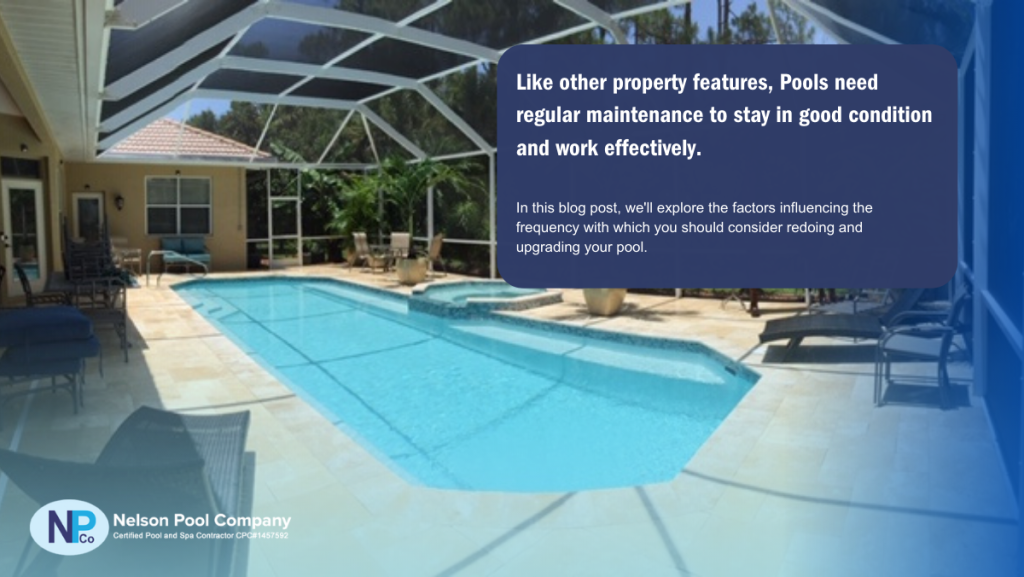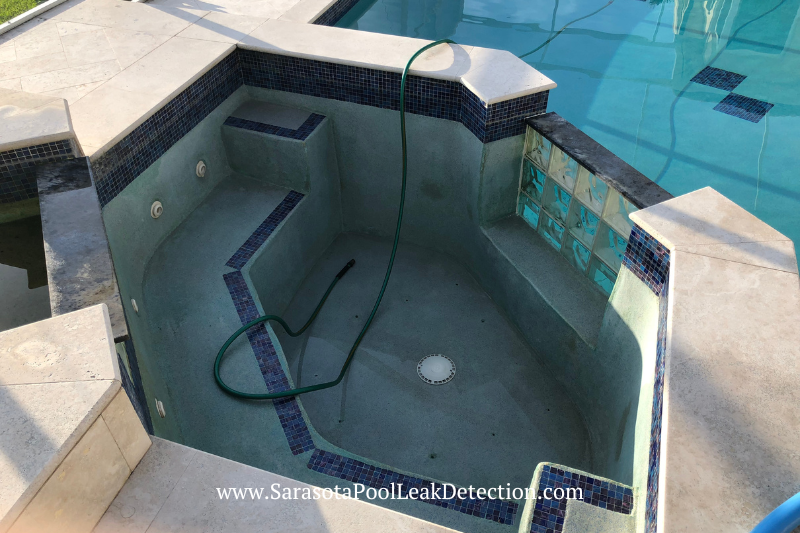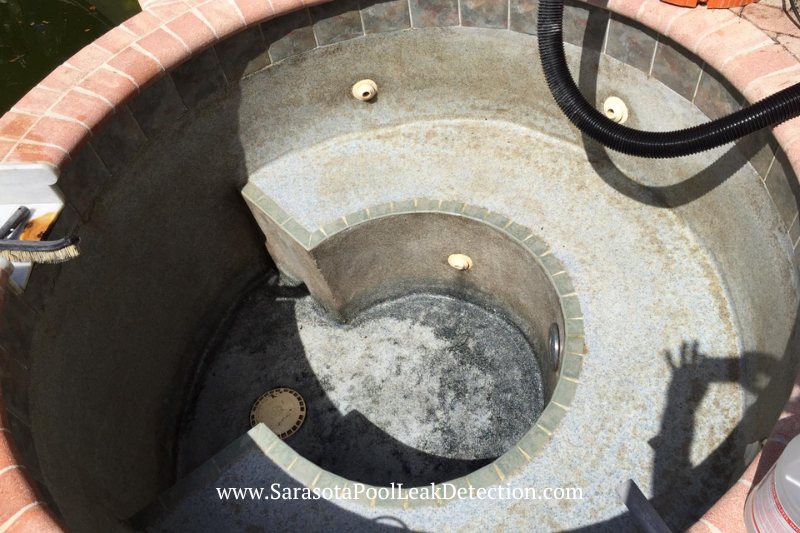Any homeowner who wants to give their family and friends unlimited fun, relaxation, and exercise should consider investing in a swimming pool.
Like other property features, Pools need regular maintenance to stay in good condition and work effectively. There may come a time when a pool requires a complete overhaul or upgrades to improve its safety, functionality, or aesthetics despite proper maintenance.

So, how often should you redo and improve your pool? In this blog post, we’ll explore the factors influencing the frequency with which you should consider redoing and upgrading your pool. We’ll provide the knowledge you need to maintain your pool in peak condition and enjoy it for many years. Whether you have an in-ground or above-ground pool or a concrete or vinyl liner.
How Frequently Should You Redo Your Pool?
The pool type, maintenance quality, usage, and environment determine how often you should resurface your pool.

Generally, vinyl liner pools may require a complete overhaul every 10 to 15 years. In contrast, fiberglass and concrete pools may last longer but require resurfacing or repairs as they age.
Your pool may need more regular renovation or upkeep if it needs to be well-maintained, is often utilized, or is exposed to harsh climatic conditions. It’s essential to watch for signs of wear and tear, structural damage, outdated design, or safety concerns to determine if your pool needs to be redone or upgraded.
Ultimately, it’s best to consult a professional pool contractor to assess your pool’s condition and recommend the appropriate action for your specific circumstances.
What Are the Factors That Influence the Need to Redo a Pool?
The need to redo and improve a pool is influenced by several factors, such as:
- Type of pool
- Level of maintenance
- Pool usage
- Environmental factors (such as climate)
Neglecting pool maintenance and upkeep can lead to extensive damage and deterioration, requiring costly repairs or complete pool replacement. Heavy usage and harsh environmental conditions can also affect a pool’s condition and lifespan.
Regularly monitoring a pool’s condition and addressing issues promptly can help extend its lifespan and minimize the need for significant redoing and upgrades.
Type of Pool
Vinyl liner pools typically have a lifespan of 10 to 15 years, and their liners may require replacement at the end of their lifespan. Fiberglass and concrete pools might endure longer. Still, they might need resurfacing or repairs over time to preserve their structural integrity and aesthetic appeal.
Level of Maintenance and Upkeep
The degree of pool care and upkeep also dramatically impacts whether a pool must be renovated and upgraded. Neglect or inadequate maintenance can lead to extensive damage and deterioration, which may require costly repairs or complete pool replacement.
Pool Usage

Pool usage can significantly influence the need to redo a pool. The frequency and amount of use and the type of activities performed in the pool can cause wear and tear on pool components, surfaces, and equipment, which may require replacement or repair over time.
Additionally, chemicals and debris from pool usage can cause corrosion or clogging in pool equipment and plumbing, which may require replacement or repair to maintain the pool’s functionality and safety.
Climate
Exposure to freezing temperatures and freeze-thaw cycles can harm the pool’s structure and piping. While prolonged exposure to heat and humidity can cause pool components and surfaces to deteriorate and fade.
In addition, strong weather conditions like storms or floods can seriously harm a pool’s construction and machinery.
What Are the Signs that Your Pool Needs to Be Redone?

There are several signs that your pool may need to be redone, including:
Wear and Tear
Over time, pool components and surfaces may wear out and become outdated or damaged, decreasing functionality and aesthetics.
Structural Damage
Cracks or shifts in the pool’s walls or floor, leaks, or other structural issues may indicate that the pool needs to be redone or repaired.
Outdated Design
An outdated pool design may not only detract from the pool’s aesthetics but also affect its safety and functionality, making it necessary to upgrade or redo the pool.
Safety Concerns
Suppose your pool does not meet safety regulations or is dangerous to swimmers. It may need to be renovated in that case.
High Maintenance Costs
It could be more cost-effective to remodel or update your pool if upkeep costs become excessive due to frequent repairs or equipment replacement.
Reduced Usage
It could be time to rethink remodeling or improving the pool if you use it less regularly because of its state or lack of utility. This will make the pool more pleasurable and functional.
Call us if you notice any of these indicators. We can check your pool and tell you what to do next.
How Often Should You Redo Your Pool Based on the Type of Pool You Have?
The frequency of redoing and improving your pool will depend on your pool type. Here are some general guidelines based on the type of pool:
Vinyl Liner Pools
Vinyl liner pools typically have a lifespan of 10 to 15 years. You may need to replace the liner at the end of its lifespan or if it becomes damaged or faded. Additionally, periodic maintenance may be required to maintain the liner’s condition.
Fiberglass Pools
Fiberglass pools are more durable than vinyl liner pools and may last up to 25 years. However, they may require resurfacing or repairs to maintain their structural integrity and appearance.
Concrete Pools
Concrete pools are the most durable but may require the most maintenance and repairs. The lifespan of a concrete pool may vary widely depending on the construction quality and maintenance level. Periodic resurfacing and repairs may be required to maintain the pool’s structural integrity and appearance.
It would help if you planned to redo and improve your pool every 10 to 15 years. Or as needed based on the condition of the pool and the level of maintenance and upkeep. It’s essential to monitor your pool’s condition regularly and address any issues promptly to extend its lifespan and minimize the need for significant redoing or upgrades.
Additionally, periodic upgrades or improvements, such as installing energy-efficient equipment or upgrading the pool’s design, can help enhance the pool’s functionality and aesthetics and increase its lifespan.
Please include attribution to https://sarasotapoolleakdetection.com with this graphic.
What Are the Cost Considerations for Redoing a Pool?
Redoing and upgrading a pool can be a significant investment. Cost considerations will depend on the project’s scope and your desired upgrades. Here are some cost considerations to keep in mind:
- Materials
- Labor costs
- Energy efficiency upgrades
- Safety upgrades
- Maintenance costs
Dealing with a reliable pool contractor is crucial for determining the project’s scale, creating a thorough budget, and choosing the best strategy for balancing cost and quality to produce the desired outcomes.
Examine long-term expenses and advantages to ensure the upgrades are worth it.
Final Thoughts
Determining with absolute confidence how frequently you should redo your pool can be challenging. You must experiment, try different products and regimens, and observe the results. Our team of pool experts can also be a big help here.
Contact (561) 570-1269 right now, and we’ll arrange a schedule in your area. We’ll arrange a time that works for you to stop by and receive a quote for what you need. Or, you may complete this form, and we’ll put you in touch with the top pool remodeling business in your neighborhood!
